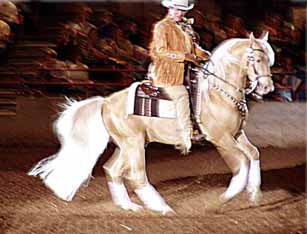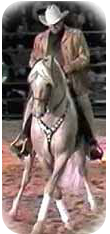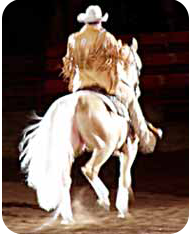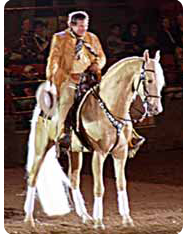COWBOY DRESSAGE
By Linda White
“Cowboy Dressage with Golden Warrior” reads the label on the video. “What in the world will this be?” we wonder skeptically as we slip the cassette into the VCR. A pale, golden Palomino Saddlebred in western tack materializes, ridden by a man in a cowboy hat and fringed leather jacket. After that, we can only smile, all skepticism forgotten. Horse and rider make a remarkable team. The handsome, pink-skinned Palomino works effortlessly, fluidly, making gait transitions like a well-oiled machine. Head set perfectly, mouth and face relaxed, eyes quiet, ears forward, the horse executes side passes at the walk, trot and canter, pirouettes on his haunches, turns on the forehand, then executes a perfect halt. He backs up four steps, a perfect, two-beat backup. His effortless passage and piaffe are things of beauty performed in classical style, and when he canters in figures of eight, his lead changes are flawless.

Throughout the performance, in perfect counterpoint to the horse’s precision and obvious pleasure in his work, the rider sits composedly, hands quiet, legs quiet, clearly inspired, enjoying himself as much as his horse is. In many ways, this performance looks more like a ballet than an exhibition of equine haute ecole. Having seen ballet impresarios Nuryev and Fonteyn perform live in their heyday, we can’t help but make a mental comparison. Some horse-and-rider combinations are decidedly earthbound: undeniably heavy and ponderous. This Palomino Saddlebred and his rider are lighter than air: breathtaking. In the video, the crowd in the stands whoops and applauds its approval. We can’t help but agree. If this is “cowboy dressage”, we’re ready to hear more about it.
We contact Eitan Beth-Halachmy, the man in the cowboy hat and fringed jacket. Eitan and his American-born wife, Debbie, own and operate Wolf Creek Ranch, outside Sacramento, California, in the Sierra Nevada foothills. Eitan, a fifth generation Israeli, rode his first horse as a small child. From the age of 13, he received his formal horsemanship training from Adam George, Director of the Israeli National Stud and former Hungarian cavalry officer. It was Adam George who instilled in the young man his profound understanding of horses, coupled with the solid foundation of classical dressage that was to influence his riding style thereafter.
When Eitan, aged 21, spent six months in the United States as a farm exchange student, he determined to return. First, however, he spent two years in Vienna, studying pre-veterinary medicine, and cleaning stalls at the Spanish Riding School.
“I was the one who picked up the foot for the horse shoer,” he admits, adding that he has been an observer most of his life. “The riding masters would never have deigned to teach a stall cleaner! The grooms at the Spanish Riding School were very knowledgeable, and willing to share what they knew, but I learned most of what I know the hard way.
“The thing that impressed me most watching the masters at the Spanish Riding School was the harmony between horse and rider,” he continues. “I had been raised with a very strong work ethic, so what I observed at the Spanish Riding School helped me set a very high standard for myself. All that I observed and learned there is a part of my training program today.
“From the time I was five years old, I wanted to be a cowboy, like I saw on the Hollywood movies. Unlike other little boys, I never wanted to be a fireman or a policeman. I wanted to be a cowboy. I was always fascinated by the symbiotic relationship between the cowboy and his horse, wherein the life and well-being of each depended on the other. It took me 28 years before I realized my dream. Today, my cowboy dressage, which combines the free spirit of the cowboy with the discipline and finesse of classical dressage, is like peanut butter and jelly. It’s a good sandwich, and a good mix. I believe that I was born to be with horses, and I learned most of what I know on top of a horse.
“My riding style is a combination of the classical riding I learned from watching the masters at the Spanish Riding School, from George Adam, the cavalryman at the Israeli National Stud, and from a man I knew only as ‘Leopold’, a circus trainer. The ‘dressage’ I learned brings the element of discipline, and the ‘cowboy’ represents freedom: absence of confinement. The combination is unique, and lots of fun: almost a dream. For every cowboy or horse person who felt intimidated by dressage, I have given them a place to go. Thanks to ‘ambassadors’ like Golden Warrior, the ice is beginning to break, and people are recognizing that this is not about being a cowboy or a dressage rider. It is about harmony and horsemanship.”
Following his two-year stint in Vienna, Eitan returned to the United States and spent the next ten years at UC Davis on a student visa. “I finally admitted to myself that I didn’t want to be a veterinarian: that I wanted to spend my life training horses. I studied everything, and did a lot of riding, which gave me a good taste of the American way of horse life,” he explains. “My only knowledge of American Saddlebreds came from seeing the actor Glenn Ford ride one in his western movies. Showing Morgans for 15 years exposed Debbie and me to Saddlebreds in the show ring, but I had no opportunity to ride one.
“Frankly,” he says candidly, “I wasn’t too crazy about that style of riding. I was brought up with classical riding, and what I saw with the Saddlebreds didn’t really appeal to me. I liked western riding. Then one day, a trainer named Lee Stein, who had been with Saddlebreds a long time, saw me give a cowboy dressage exhibition with my Morgan stallion, Holiday Compadre. [Note: Holiday Compadre and Eitan, his only trainer, won 1993 and 1996 Morgan World Champion Western Pleasure Horse titles.]
“Lee had just gotten in a young Palomino Saddlebred he thought would fit into my style of riding. The horse had been born and raised in Florida, and some California people, Kitty and Tony Miszklevitz of Pine Hill Ranch in Lower Lake, had bought him as a two-year-old. This horse had so impressed Lee Stein, their trainer, that he said, ‘You need to evaluate him.’ Miszklevitzes were the actual owners of Golden Warrior when he arrived here. Kitty has owned and loved Saddlebreds all her life.
“Lee brought the horse over to me, and I liked him from the first minute I saw him. He was so charismatic, with his champagne color and silvery white mane and tail. Turned loose in the round pen, he again impressed me, initially because I look at a horse from the ground, up: no feet and legs, no horse. He had excellent feet, correct legs and structure, and good, flat bone. His movement was the next thing that impressed me. This horse carried himself differently from most horses: rounding himself, with cadence and rhythm. He had been broke to drive and had had a saddle on, but he knew very little.
“Stein left the horse, Galahad Golden Warrior with me for three months. I’ve ridden a lot of horses, and I always have to work hard to get them going forward, but this horse was so true-gaited that he wasn’t hard work to ride. Instead, he had so much impulsion that he was a pleasure to ride. What I saw was a horse that was engaged all the time, never leaving his hocks behind. From the first day, he had a very comfortable balance that I was able to control. He didn’t have much knee motion because I was riding him lower, for more ground-covering, forward motion. Obviously, the higher the horse’s head, the more knee action he’s going to have,” he adds parenthetically.
“He was always eager, and very quick to learn. The average horse tends to be lazy, but this horse was different: he always gave me more than I wanted. In fact, he was so bright and inquisitive that, like a precocious child, he could have been dangerous in the wrong hands. I started with Arabians, then Lipizzaners. When I came to the United States, I got on a Quarter Horse, then went to Hanoverians, and Dutch warmbloods – but I like an ‘uphill’ horse, not a ‘downhill’ horse – which is the reason I didn’t stay long with Quarter Horses and warmbloods.
 |
 |
 |
“From spins to piaffe, Golden Warrior has collected, ‘uphill’ carriage, impulsion and maneuvers. I got a call from a Saddlebred person in California who asked me if I thought Saddlebreds could be competitive in dressage. I told him sure, but you can’t make a dressage horse out of just any Saddlebred. You have to start breeding horses that have the conformation and movement to do dressage. You need a Saddlebred with a long, well laid-back shoulder, ground-covering motion and a long stride, rather than high, trappy knee action.”
As we know, the American Saddlebred is a natural athlete, with the sane temperament and bottomless work ethic to undertake whatever is asked of him. Strong, flat bone and durability are also breed hallmarks, as is the Saddlebred’s natural style. No matter how mundane the job, the Saddlebred will look better performing it than any other breed. After two years with Eitan, Golden Warrior’s dressage work was closely approaching Prix St. Georges level. Quiet and reasonable to deal with in the stall or on the ground, Golden Warrior with a saddle on becomes incandescent; transformed.
“‘That’s not a horse, that’s a fantasy!’ someone told me at an equine expo in Colorado recently,” notes Eitan. “This horse has so much potential, we will probably never get to the end of it. Even with all this foundation, he is still on the first floor of his ability – and he is so willing to do whatever I ask. I used him to demonstrate in my last training videotape, and have done many clinics and exhibitions with him, including Equus America, Dressage in the Wine Country, Western Idaho Horse Fair, the Great Northwest Equine Expo, and many others.”
Who is this wonder horse? A foal of February 03, 1996, Galahad’s Golden Warrior was bred by Emerald View Stables, Inc. of Delray Beach, FL. His sire, Galahad’s Gold Mine, was a son of chestnut parade horse Galahad (Supreme Sultan x CH Gala Affair, by Denmark’s Bourbon Genius). Galahad’s Gold Mine, with only seven registered offspring, was out of the mare Mistress of Motion (Golden Dynasty x Pride of Major, by Our Major Dare). From Golden Dynasty, who traces to respected paterfamilias Paul’s Palomino Peavine through son Peavine’s Golden Belvelier, came the pink-skinned Palomino color.
Cowboy dressage star Galahad’s Golden Warrior is out of the chestnut mare Fairview’s Feather, by Monsieur Americus Denmark (Americus Denmark x Dancing Waters, by Reveler). Fairview’s Feather is out of the black mare Stonewall’s Opening Midnight, whose own antecedents Stonewall’s Midnight Squirrel, and dam, Opening Night, by Dare’s Black Rex, were also black. Interestingly, representing yet another recessive, color variation, Dancing Waters, a grey, was out of the grey mare Sea Scape, by golden chestnut Captain Courageous (and remember: genetics tells us that all grey horses must have one grey parent.)
What does the future hold for this exceptional Saddlebred? At this writing, his owners, Dr. and Mrs. James Warson, who purchased Galahad’s Golden Warrior three years ago, have taken their horse home to Fort Collins, CO. The Warsons, their twin granddaughters, Tiffany and Tamara, and five horses, including Galahad’s Golden Warrior, will be relocating to Hawaii in July.
“Eitan did a wonderful, wonderful job with Golden Warrior,” notes Joyce Warson. “We had the horse gelded on April 23, but his frozen semen will be available. Golden Warrior and four other horses will be flown to Hawaii, and Golden Warrior will be a trail horse the rest of his life. We are moving to a ranch area with 28 miles of trails, and we are all looking forward to enjoying this amazing horse.”
Needless to say, after their remarkable experience with the Palomino wunderkind, Eitan and Debbie Beth-Halachmy soon hope to find another Saddlebred prospect with similar potential. We know they’re out there: could that be one standing there in the paddock, just outside your dining room window?
